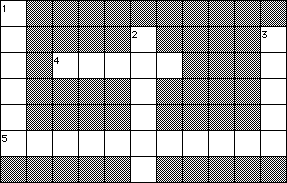Login form
Student Created Crossword Puzzle Exercise
Teachers often give crosswords based on reading texts to their students. This is a good idea, but an even better idea is to have students in small groups work together to create crossword puzzles based on texts, which they will give to another group to solve. I have done this with different texts in several classes and each time my students have applied themselves with great concentration to the task.
It is important that you have students do this in steps. The first step is to provide the students with a text and a small sample crossword puzzle based on the text you have made. Have students solve the puzzle. Then explain that they will create their own crossword puzzle. It is important to explain that each word in the puzzle must be related to the text. Also, make it clear that letters which touch in the crossword puzzle must make words.
Below is a text and a sample crossword puzzle my students solved before creating their own puzzles. Following the sample crossword puzzle is the blank crossword puzzle form I gave the students to use.
The Seashore
Two-thirds of the earth is covered with water. The unique area where the sea and land meet is called the seashore or sometimes the shore. Along the seashore live a variety of plants and animals. Every shore is different and each shore is constantly changing. If you go to a beach at the same time for two days, you will see different animals and plants in different places. The waves will be different. Each day, you will see different objects, moved by the power of the sea.
If you stay at a seashore, you will notice the sea coming up to the land or moving away from the land. This movement is called the tide. High tide is when the sea comes up towards land. When the sea moves away from land, it is low tide. Tides are created by the moon and sun. The area of seashore that is under water at high tide and above water at low tide is the intertidal zone. Many animals and plants living in the intertidal zone can live in and out of water.
Along seashores, we often see plants that live in the intertidal zone and the subtidal zone, which means the area which is not uncovered by low tide. The subtidal zone is always below water. Plants in the sea are usually called seaweeds. Unlike plants on land, seaweeds never have flowers. Many animals eat seaweeds or other animals that live on and near seaweeds, such as crabs, fish prawns, etc. The California sea otter often wraps its body with seaweed before sleeping to stop it from moving in the ocean. Humans use seaweeds for food, fertilizer (plant food), medicine, and many other uses. One species of seaweed, called the giant kelp, can grow to over 100 meters long.
People often gather mollusks at the seashore. Mollusks are animals which usually have a soft body that is protected by a hard shell. They usually move very slowly on a muscular footlike body part. Commonly eaten mollusks are clams, oysters, scallops, abalone. Squid, and octopus are mollusks without hard shells.
At the seashore close to where I live, I often see people gathering sea-urchins, which are animals that look like balls with many long, sharp needles. The yellow and orange eggs of sea-urchins are very popular in Japan. Although sea-urchins are small, they are powerful enough to scrape holes in rocks and metal.
Tide pools are small, but fascinating habitats. Tide pools are small pools in which water stays during low tides. Small fish, starfish, crabs, and sea anemones are commonly found in tide pools. Fish that live in tide pools have eyes near the top of their heads so they can watch for birds. Sea anemones look like flowers, but they are animals that catch and eat other animals with their flowerlike parts.
Unfortunately, humans are quickly destroying seashores with pollution and habitat destruction. The earth needs our protection. When you go to a seashore, do not litter. Please pick up and take garbage away. Plastic bags and other garbage kill millions of sea animals every year.
Cross Word Puzzle

Across
4. 2/3 is covered with water.
5. Japanese love to eat their eggs.
Down
1. Hard things that protect most molusks.
2. Animals that sleep with seaweed.
3. Movements of water up and down seashores.
Make Your Own Crossword Puzzle
Write the words on the puzzle form and write your clues with a pencil. Write the numbers for each word with a pen. When you have finished writing the words and clues, use a pen to draw borders around the words. After that, erase the words and pass the crossword puzzle to another group for them to solve.

Across Down
Source: http://iteslj.org

